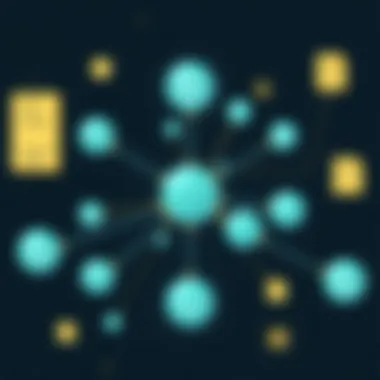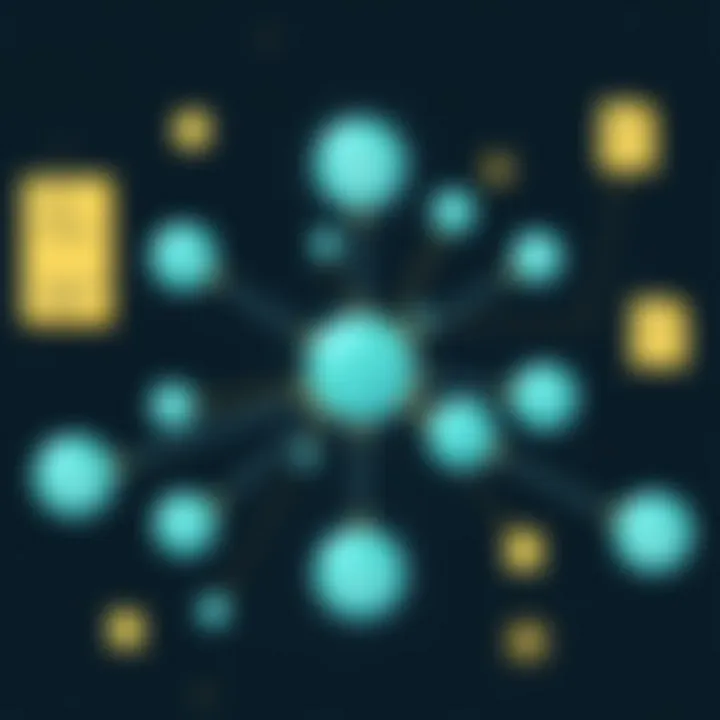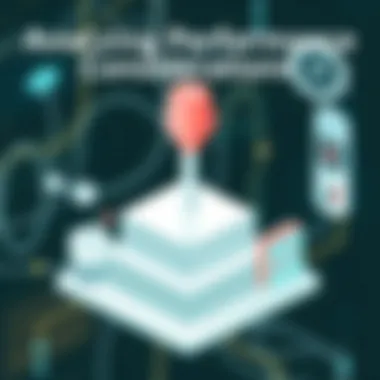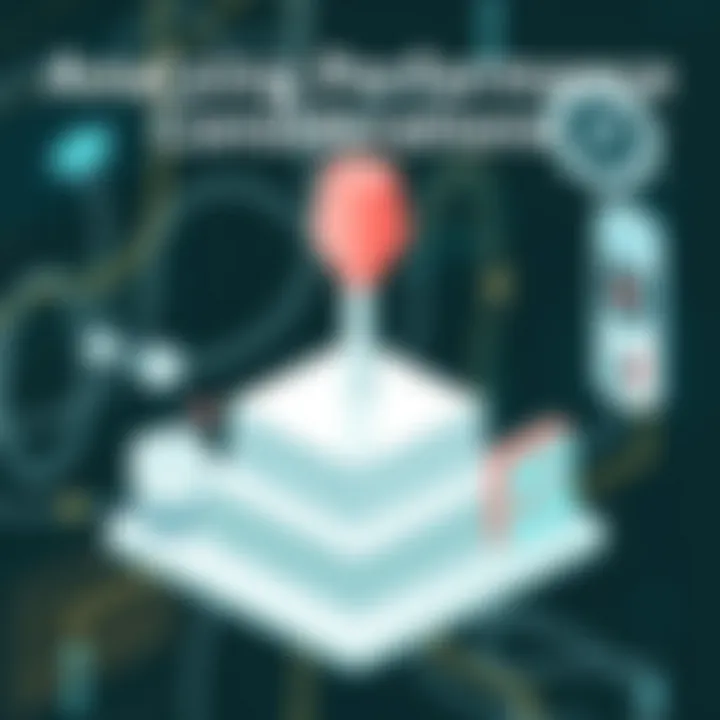Deep Dive into MongoDB as a Graph Database Solution


Intro
In the landscape of modern data management, the significance of efficiently organizing, retrieving, and analyzing relationships among data is paramount. As businesses navigate through massive datasets, the use of graph databases has emerged as a viable solution to depict intricate networks and data interconnections. At the forefront of this evolution is MongoDB, a document database recognized not only for its versatility but also for its capabilities as a graph database.
Graph databases like MongoDB allow users to visualize data relationships beyond traditional relational database paradigms, offering an intuitive approach to data connectivity. In this comprehensive guide, we will delve into the inner workings of MongoDB as a graph database. We will highlight essential features, discuss technical specifications, share peer insights, and reflect on real-world applications that illustrate its transformative potential across various industries. By the end of this exploration, tech enthusiasts and industry professionals alike will gain a deeper understanding of utilizing MongoDB to harness the full power of graph databases.
Intro to Graph Databases
Graph databases have carved a niche in how we manage and interact with complex data relationships. They break away from traditional relational database structures, enabling a more flexible approach that mirrors how data exists in the real world. This flexibility becomes particularly essential as organizations face the challenges posed by rapidly changing environments and evolving data sets.
By prioritizing connections and relationships over mere data storage, graph databases offer a more intuitive framework for applications involving interconnected data. Think of social networks, recommendation engines, or fraud detection systems, which thrive on these complex interdependencies. In this context, graph databases like MongoDB present a compelling solution, bridging the gap between raw data and actionable insights.
The discussion around graph databases goes deeper than just their configurations. Understanding their fundamental essence — how they define, store, and query data — can unveil their transformative potential for business use cases. Challenges such as performance, optimal querying, and the scalability of databases also come into play, making a thorough exploration of these elements imperative.
Defining Graph Databases
At its core, a graph database is structured around graph theory concepts, where data is represented as nodes, edges, and properties. A node can represent an entity—such as a person, place, or event—while an edge depicts the relationship between those entities. Each of these elements can carry additional information in the form of properties, which adds granularity and depth to the dataset.
This structure allows for swift traversal and querying of interconnected data. For instance, in a social network application, traversing relationships can foster insights into friend connections or community structures, which are difficult to represent in traditional tabular databases.
"Graph databases change the game by emphasizing the relationships among data and allowing insights to emerge from connections rather than just individual entities."
Key Concepts and Terminologies
When diving deeper into graph databases, a few key terms frequently surface. Vertices represent the nodes in the graph, often termed entities with unique identifiers. Similarly, edges symbolize the relationships, often carrying attributes that describe the nature of their connection.
A property can be attached to both nodes and edges. For example, in a movie rental application, a node could represent a movie, while the edges could signify relationships like "directed by" or "watched by." Properties might include release dates or ratings, making the entire structure meaningful.


It's also essential to be aware of graph traversals, which involve navigating from one node to another through edges, allowing complex queries to be processed efficiently. This concept of traversal highlights how relationships influence data querying significantly, making it a cornerstone for developers and data scientists alike seeking to extract meaningful insights from their datasets.
As we explore MongoDB as a graph database framework, understanding these foundational elements will illuminate how this technology integrates and innovates in the realm of graph databases, steering forward the conversation about data in an increasingly interconnected digital landscape.
MongoDB Overview
In understanding MongoDB as a graph database solution, it’s crucial to grasp how this powerful platform has evolved and the unique features it offers. MongoDB isn't just another database; it's a flexible, scalable, and efficient solution that caters well to graph-based data environments. Its architecture allows for rich data relationships, which is essential when modeling intricate systems like social networks or recommendation engines.
Origins and Evolution of MongoDB
MongoDB was founded in 2007 by Dwight Merriman, Eliot Horowitz, and Kevin Ryan. Initially, the team aimed to build a better storage system for applications that needed more flexibility than traditional relational databases could offer. Instead of adhering to a rigid schema, MongoDB evolved to embrace a document-oriented structure, accommodating vast amounts of varied data with ease.
From its early days, MongoDB has journeyed through several versions, each introducing enhancements that address scalability and performance, while also focusing on ease of use. For example, the introduction of features like sharding and replication allows MongoDB to scale horizontally by spreading data across multiple servers and ensuring high availability through redundancy.
As a result, it has become a preferred choice for many organizations aiming to manage big data, including startups and Fortune 500 companies. The evolution of this technology reflects a shift in how software developers approach data management, embracing flexibility and accessibility over conventional, fixed structures. This adaptability is a game changer in diverse sectors, like healthcare, finance, and e-commerce.
Core Features of MongoDB
MongoDB offers a suite of compelling features specifically tailored for managing graph data effectively. Here are some key highlights:
- Document-Oriented Storage: This allows data to be stored in JSON-like documents, making it easier for developers to work with nested data structures, which is common in graph databases.
- Dynamic Schema: Unlike traditional databases, MongoDB doesn’t require a predefined schema. This flexibility allows new data types to be integrated seamlessly, which is particularly important in rapidly changing environments.
- Powerful Query Language: MongoDB provides a comprehensive query language that supports complex queries across multiple documents. This becomes invaluable when traversing relationships in a graph structure.
- High Availability: With features such as replica sets, MongoDB encourages fault tolerance, ensuring that applications remain available even in the face of individual server failures.
- Scalability: MongoDB can easily handle large data volumes. Techniques like sharding enable organizations to distribute data across various servers, improving performance in high-demand situations.
In summary, MongoDB combines a rich set of features with an adaptable framework, making it a top-of-mind solution for handling graph data. With ongoing improvements and a focus on the needs of modern applications, it positions itself as a leader in the realm of graph database technology.
Graph Database Features in MongoDB
Understanding the specific features of MongoDB that cater to graph database applications is pivotal for those looking to harness its power effectively. MongoDB’s approach provides flexibility, ease of use, and efficient performance for graph-oriented queries. As organizations increasingly need to manage vast amounts of interconnected data, MongoDB stands out with its rich feature set. This section will dive into critical aspects such as schema design, document storage, and indexing strategies intrinsic to the MongoDB environment, revealing how each contributes to its capabilities as a graph database.
Flexible Schema Design


One of the notable features of MongoDB is its flexible schema design. Unlike traditional relational databases that impose strict schema requirements, MongoDB is built on a document-oriented model. This means that developers can store data in a variety of formats, and the structure can evolve without the need for a major overhaul.
This flexibility is essential for graph databases, where relationships can change dynamically based on the nature of the data. For instance, if a company initially captures data about users and their connections, they might later want to include additional attributes about interactions or behaviors. In MongoDB, you can simply add new fields to your documents representing those relationships. This adaptability not only accelerates development but also aligns well with Agile methodologies, allowing teams to iterate quickly.
"With a flexible schema, the future growth of your application is no longer constrained by predefined formats."
Document-Oriented Storage
MongoDB’s document-oriented storage paradigm allows for storing complex data structures in a straightforward manner. Each document within a collection can represent a node in a graph, containing all relevant details about that entity and its connections. For example, in a social network application, a user’s profile, including friends, interests, and messages, can be encapsulated as a single document.
This storage format enhances the querying process, as related data is housed together. When conducting graph queries, retrieving deeply nested relationships becomes a more efficient task since the data is stored in a readily accessible manner. The use of BSON (Binary JSON) format means that data can include arrays and sub-documents, further enriching the representation of complex associations. This structure ultimately leads to reduced latency in data retrieval, allowing for real-time analytics and decision-making.
Indexing Strategies for Graph Data
Effective indexing is vital when leveraging MongoDB as a graph database, especially with intricate networks where relationships can multiply. MongoDB provides various indexing options that optimize query performance for graph data. For instance, creating indexes on fields that define connections, such as user IDs or timestamps, can significantly enhance the speed of traversal operations.
Choosing the right indexing strategy involves understanding the types of queries that will be run on the database. In a graph context, it’s crucial to create indexes that support not just lookup functions, but also pathfinding algorithms, which are fundamental for traversing nodes.
MongoDB also supports compound indexes, allowing multiple fields to be indexed together. This feature can be particularly useful when combining attributes from various nodes, thus fine-tuning search effectiveness.
To summarize, harnessing the diverse graph database features of MongoDB involves leveraging flexible schema designs, document-oriented storage, and strategic indexing. Each aspect contributes to creating a robust data architecture capable of supporting intricate relationships and data models, essential for modern applications across industries.
Data Relationships in MongoDB
Data relationships constitute the backbone of graph databases, acting like an intricate web that connects various elements of data. MongoDB, with its document-oriented structure, brings a fresh approach to modeling these relationships. Recognizing how data interconnects is essential for making informed decisions and extracting insights.
Understanding Relationships in Graphs


At its core, a graph database treats data as interconnected nodes and relationships. This model allows for the representation of complex relationships amongst various data points—each node can be a standalone entity, like a user or product, while edges connect them, depicting interactions or associations.
Understanding relationships in graphs essentially boils down to identifying how different pieces of data relate to each other. For instance, in a social networking app, users (nodes) can connect with friends through relationships (edges). This representation is intuitive. It mirrors how humans naturally interpret social connections.
Graphs can represent various types of relationships such as juvenile friendship patterns, professional networks, and familial ties. Each type sheds light on different behaviors and implications. Moreover, different relationships can be weighted differently; for instance, a close friend relationship might hold more weight than an acquaintance one. This capability of the graph model offers a nuanced view of interconnected data, leading to better analytics and insights.
Modeling Relationships in MongoDB
When it comes to modeling relationships in MongoDB, it allows flexibility that more rigid database systems often lack. Users can approach relationships in two primary ways: Embedding or Referencing.
- Embedding involves nesting documents within documents, effectively connecting them in a single structure. This approach can enhance performance when accessing related data because it minimizes the number of queries needed. For example, an embedded document for a user might contain all details regarding their posts or comments within their user profile.
- Referencing, on the other hand, uses separate documents and links them through identifiers. This provides a more modular approach, keeping the data physically separate but logically connected. This is particularly useful when dealing with large datasets, wherein embedding might lead to significant redundancies or data bloat.
Choosing between embedding and referencing hinges on the specific use case and how the data will be queried. For example, if the user’s information is consistently called together, embedding makes sense. However, if the relationships or data points may grow in complexity, referencing can yield a more manageable model.
Querying Graph Data with MongoDB
In the realm of graph databases, effectively querying the data is akin to wielding a powerful tool that enables organizations to uncover insights hidden within complex relationships. MongoDB, while primarily recognized for its versatility as a document database, offers unique capabilities that make it a strong contender for querying graph data. The significance of this topic lies in its ability to simplify complex data relationships, providing businesses from various industries with the means to derive actionable insights from their data.
When it comes to querying graph data in MongoDB, there’s a lot on the plate. The aggregation framework stands as a pillar of functionality, allowing users to perform sophisticated transformations on their data while adopting an easy-to-understand syntax. Additionally, it enriches the database’s capabilities by enabling users to seamlessly traverse through the connections between documents. This brings light to the natural relationships between pieces of data.
Using MongoDB Aggregation Framework
The MongoDB Aggregation Framework is a game changer for many. It empowers professionals to perform deep data analysis without having to jump through a dozen hoops. This framework doesn’t just allow standard data retrieval; it features stages for filtering, grouping, and transforming data based on specific criteria.
For example, imagine you are analyzing user interactions in a social media platform. With the aggregation framework, you could easily pull data that highlights common connections or trend analyses without the need for complex queries. This is not just about fetching data; it’s about crafting a narrative through analytics.
The structure of the aggregation framework is made up of stages, each serving a distinct purpose:
- $match: Filters the documents to choose a subset that meets specified criteria.
- $group: Groups input documents by a specified identifier, often for statistics or aggregations like averages.
- $project: Reshapes the output, allowing you to include, exclude, or add new fields.
json
"user_id": 1, "friends": [2, 3, 4], "post_count": 42







